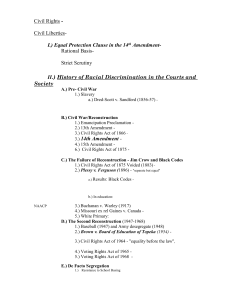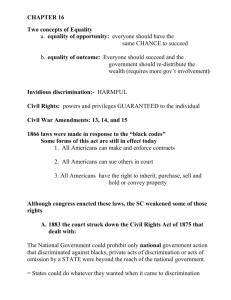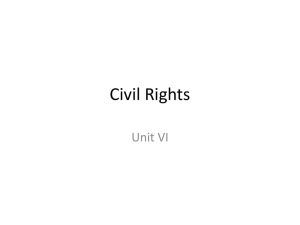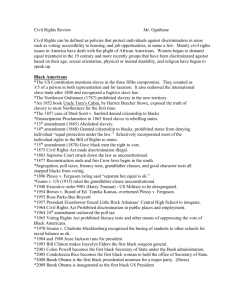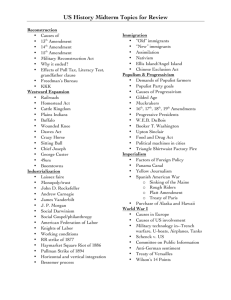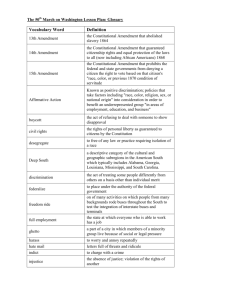AP GOV'T Civil Rights I
advertisement
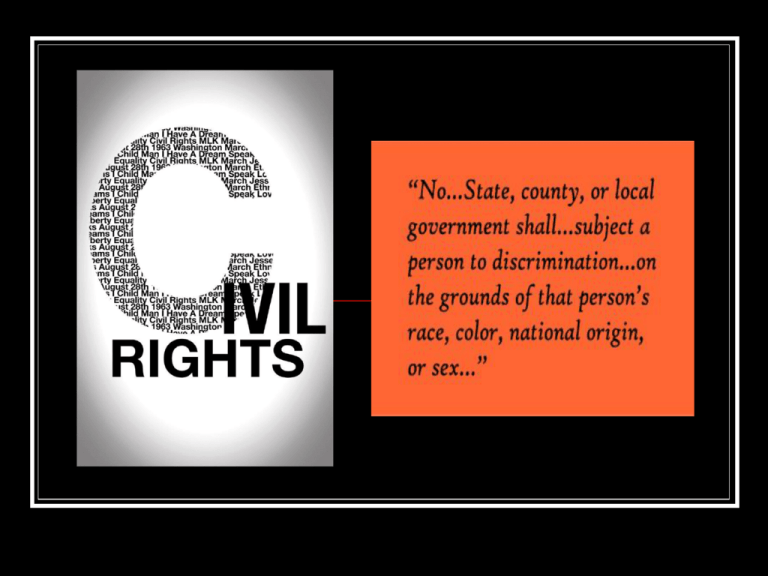
What ARE Civil Rights? CIVIL RIGHTS = Rights of all persons, regardless of race, religion or sex to equal treatment under the law. Providing equality to groups that have historically been subject to discrimination. The question is NOT whether government can treat, or classify, people of different races, ethnicities, genders differently. . . Instead, it is whether such differences in treatment are REASONABLE. Generally, classifying people on the basis of race or ethnicity is deemed unreasonable – a “SUSPECT CLASSIFICATION” Civil Rights & the Constitution Who was included in our early views of equality? The original Constitution is a plan of government, not a guarantee of individual rights. It DOES ensure that: 1) Gov’t does not discriminate against us 2) Gov’t protects us from interference by private individuals. The Framers referred to these rights as “NATURAL RIGHTS” – the rights of all people to dignity & worth. Today they are called HUMAN RIGHTS. So …what exactly is EQUALITY? Equality OF: Freedom “to” exercise individual rights and Freedom “from” government interference UNLESS it compromises someone else’s rights Equality OF opportunity – all can go for it…..this, of course, also means competition will exist. Equality OF Outcome - i.e., Affirmative Action - not just a boost but seen as government having an obligation to promote minority development…. blacks, Hispanics, females, etc. Equality ….What is it exactly? Equal Justice - not equal results or equal rewards. . . the Constitution does NOT intend to provide equal condition. . . just equal opportunity “Equality” is not even mentioned in the original Constitution. The first mention is in the 14th Amendment: All will have “equal protection” under the law unless there is a “compelling public interest” to discriminate. So….. . . to right a past wrong, you may have to discriminate! (affirmative action for example) AFRICAN AMERICAN ISSUES ERA OF SLAVERY / ERA OF RECONSTRUCTION 13th Amendment– 1865 prohibits slavery overturned Dred Scott v. Sanford 14th Amendment– 1868 Equal protection; citizenship 15th Amendment Right to vote for MEN (1870) FREE MEN VOTE! AFRICAN AMERICAN ISSUES ERA OF SLAVERY / ERA OF RECONSTRUCTION BUT, society did not transform as quickly. Segregation and White Supremacy prevailed. Reconstruction ended in 1877 w/ Whites in control of the “New South,” and blacks were left to Jim Crow Laws that preached a separate society. Ineffective Civil Rights Acts passed …. And then invalidated in the Civil Rights Cases of 1883 14th Amendment corrects actions by states … NOT actions by private citizens “Individual invasion of individual rights is not the subject of the amendment.” Jim Crow Laws Right after the Civil War there were Black Codesrestrictive laws such as labor contracts and vagrancy codes to keep freemen as submissive laborers Jim Crow laws- state and local laws imposing segregation, late 1800’s1960’s, upheld by Supreme Court’s “separate but equal” Plessy v Ferguson ruling Plessy v. Ferguson AFRICAN AMERICAN ISSUES ERA OF RECONSTRUCTION…… Voting Discrimination Other forms of discrimination: Housing discrimination Job discrimination Discrimination in accessibility to public accommodations NAACP formed in 1910 – how does it work? LAWSUITS to achieve civil rights Denial of Black Vote in the PostReconstruction South: The Great Migration • During WWI & WWII eras - Blacks migrated north to the cities and their sheer numbers (6 million) became a political force as middle class became accessible • During WWII. . . judicial relief sought • Truman started integration of the military • Ike integrated Fed Bureaucracy AFRICAN AMERICAN ISSUES ERA OF CIVIL RIGHTS 1950’S - BLACKS SEEK POLITICAL MUSCLE: MLK, Jr., using the First Amendment - freedom of petition sought relief via civil disobedience white supremacists responded with fire hoses and police brutality Congress dragged its feet w/ a Southern Senatorial block, so Executive and Judicial branches responded. Brown v. Board of Education (1954) Overrules Plessy v. Ferguson Brown II Ruling? AFRICAN AMERICAN ISSUES Segregation by law “de jure segregation” was unconstitutional. But “de facto segregation”segregation by choice or reality- still prevailed … until Swann v. Charlotte Mecklenburg Board of Education 1971 where the SC ruled that schools will re-district to end segregation via BUSING, a very unpopular device to integrate! OVERVIEW OF EVENTS/STRATEGIES IN THE CRM Rosa Parks & Montgomery Bus Boycott (1955) Little Rock 9 school integration ’57 Lunch counter sit-ins ’60; Freedom Riders ‘61 Birmingham March/riots 1963: March on Washington 1964 Civil Rights Act of 1964 TRIBUTE to JFK; enacted after death No discrimination in schools, workplace, public accommodations Selma March; Voting Rights Act of 1965 The “New Direction” by the mid-60’s JFK FINALLY promoted civil rights legislation SNCC, Black Power, Malcolm X, Black Panthers Long, Hot Summers of 1965-1967: Watts, Detroit, Harlem The Civil Rights Act of 1964 The Civil Rights Act of 1964 was landmark legislation in the United States that outlawed segregation in U.S. schools and other public places. First conceived to help African Americans, the bill was amended prior to passage to protect women in courts, and explicitly included white people for the first time. It also started the Equal Employment Opportunity Commission. It prohibited discrimination in public facilities, in government, and in employment, eliminating the Jim Crow laws in the Southern United States. President Lyndon Johnson signs the Civil Rights Act of 1964 Early Civil Rights Movement Goals and Strategies MLK & SCLC - Southern Christian Leadership Conference sought integration Modeled after Ghandi Preached non-violent protests / civil disobedience to achieve equal rights. CRM by the mid to late 60’s Violence, Militancy & Separatism SNCC started out as nonviolent (lunch counter sitins) but …. Stokely Carmichael takes over – “go get you some guns!” Black Power! Malcolm X Initially separatism but … Black Panthers most militant What caused the change? Voting Rights Act of 1965 Only 70 blacks held elected office in 1965 Sent federal registrars into South to register blacks Voting Rights Act outlawed methods used by states to deny the vote to blacks: poll taxes (24th Amendment) white primaries grandfather clauses literacy tests gerrymandered districts. Still not enough minorities getting elected so legislature encouraged “minority v. majority” districts that promoted minority electorates . . . But Shaw v. Reno, Bush v. Vera and other cases have condemned the design of districts using race as the predominant factor. The Passing of the 24th Amendment January 1964 24th Amendment Poll taxes had been enacted in eleven Southern states after Reconstruction as a measure to prevent poor people from voting. These taxes stayed in force until an amendment to the Constitution made them illegal in 1964. At the time of this amendment’s passage, only five states still preserved the poll tax: Virginia, Alabama, Texas, Arkansas, and Mississippi. However it wasn’t until the U.S. Supreme Court ruled 6-3 in Harper v. Virginia Board of Elections that all state poll taxes were declared unconstitutional because they violated the Equal Protection Clause of the Fourteenth Amendment.
